The twin engine, straight winged, Gloster Meteor jet was the Allies first operational jet fighter of WWII. During the war, it saw limited combat but never got the chance to engage any of the German jets in aerial combat. Six years later in the skies over Korea, the Meteor fought against the MiG-15 jet fighter flown by Chinese and Russian pilots.
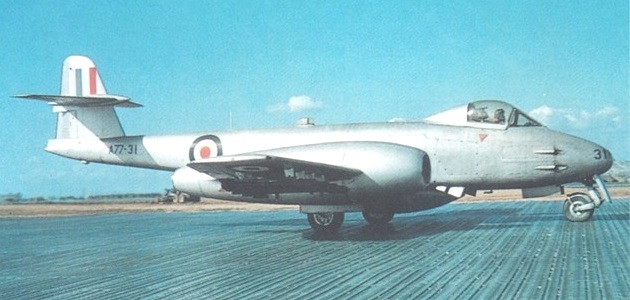
In the early 1930s, Frank Whittle, a young British engineer serving in the RAF worked privately on a new engine design. His engine design was a gas turbine driving a series of enclosed impellers instead of the normal external propeller. He received mixed feedback from sections of the military about his new engine design. He received a lot of support from within the RAF but the Air Ministry rejected his proposals which forced him to privately patent the design.
By the mid 1930s, Whittle formed his company, Power jets Ltd. to develop his designs from the drawing board to a flying prototype. While development of his engine continued, he was constantly searching for a suitable air frame. In 1939, he met George Carter, Chief Designer of the Gloster Aircraft Company and their continued collaboration led to a jet powered combat aircraft design. It was around this time when the Air Ministry began to take an active interest in the project and issued a contract to Gloster for a new jet propelled aircraft prototype.
The first prototype was the Gloster E28/39 or often referred to the Gloster Whittle. On 15 May 1941, the first single engine jet aircraft, serial W4041, made its maiden flight from RAF Cranwell flying for only just over 15 minutes and successfully landed. A second improved E28/39 was built and its first flight was on 1 March 1943 but about four months later, the aircraft was lost when the test pilot had to bail out of the aircraft. The loss of the aircraft did not adversely affect the program since the Air Ministry issued a contract for 500 aircraft under the specification F9/40 which called for a twin engine jet fighter.
Gloster Meteor Variants

Gloster F9/40:
Unarmed prototype and only eight were built.
Meteor F.1:
First Welland-powered production aircraft with car door canopy. Only 20 were built between 1943 and 1944. It had short engine nacelles with protruding jet pipe and long span wings.
Meteor F.3:
Derwent I powered, with sliding canopy and 210 were built (the first 15 were Welland-powered). It had long engine nacelles with enclosed jet pipe and short span wings. First flown on 11 September 1944. Serial Numbers were: EE230 to EE254, EE269 to EE318, EE331 to EE369, EE384 to EE429, EE444 to EE493
Meteor F.4:
Derwent 5 powered with strengthened fuselage, 489 were built by Gloster and 46 by Armstrong Whitworth. It entered service after WWII.
Meteor T.7:
Unarmed two-seat trainer variant of the F.4 with a long framed canopy and optional under wing fuel tanks. The prototype first flew on 19 March 1948 and 640 production aircraft were built for the RAF and 43 for the Royal Navy.
Meteor F.8:
Improved variant of the F.4 with a longer fuselage, greater fuel capacity, standard ejection seat and modified taller tail. It was the RAF front line jet fighter during 1950–54.
The first flight of the Gloster Meteor was on 5 March 1943 at RAF Cranwell. At the controls was Gloster’s chief test pilot Neil ‘Michael’ Daunt. With the serial number DG206/G, it was the fifth of the eight F9/40 prototypes built.

The RAF No. 616 Squadron (code YQ) of the Auxiliary Air Force was selected to be the first unit to receive the new Meteor F.1. The squadron had just moved to Culmhead in Somerset and was currently flying Spitfire VIIs on armed reconnaissance missions over France prior to the D-Day landings and they expected that shortly they would be receiving Spitfire XIVs but little did they know what was in store for them.
The first production Meteor, serial EE219 was delivered to the squadron on 12 July 1944 and shortly afterwards the unit was to move again, this time to Manston in Kent which became the squadron’s home while they reached full operational status with the Meteors. After flying the Meteor for a week, over 30 pilots had successfully converted to the new type. The squadron only received 14 of the 20 Meteor F.1s built. The remaining 6 were used for various tests and trails.
Film: First Jet Planes in Action
Instead of engaging the German jets in aerial combat, the RAF initially decided to use the Meteor to counter the German’s first vengeance weapon, the V-1 “Buzz Bomb.” Code named “Divers” by the RAF, the V-1s were a major threat to the British civilian moral especially since the allies invasion of the mainland Europe had just begun. The Meteor was to close in on the V-1 from behind over an unpopulated area and shoot it down with its four nose mounted 20mm (.79 in) Hispano Mk V cannons. This was easier and safer than attacking a piloted aircraft since the V-1 could not take evasive action or fire back.
On 27 July 1944, the first V-1 interception was made over Kent by Squadron Leader Watts and Pilot Officers Dean and McKenzie. Dean and McKenzie did not intercept any bombs but Watts caught up with a V-1 over the town of Ashford. He press the trigger to fire his 20mm guns but nothing happened. His guns had jammed and the V-1 continued on to its target. After this event, it was decided that patrols were to be carried out by pairs of Meteors since the chance that the guns on both aircraft jamming at the same time was very slim.
On August 4, the squadron’s first success came when Dean sighted a V-1 heading towards Tunbridge Wells ahead and below him. Dean put his Meteor into a shallow dive, increased his speed to 450 mph and fired a brief burst with his guns before they jammed. Dean then moved his Meteor along side the V-1 as close as he felt was safe and with a vigorous flick of the yoke (control Column) banked his Meteor over sharply. The sudden force of air under the V-1’s wingtip rocked the V-1 which unbalanced the gyro auto pilot in the bomb causing it to spiral out of control and crash into the ground. This was the first successful execution of the “tip and run” tactic by a Meteor against a V-1. The Meteor’s wingtip did not actually touch the V-1, just passes close enough underneath the V-1’s wing where the air pressure disrupts the air flow of the V-1’s wing. This was an effective alternate method to destroy a V-1 if the Meteor’s guns jammed.
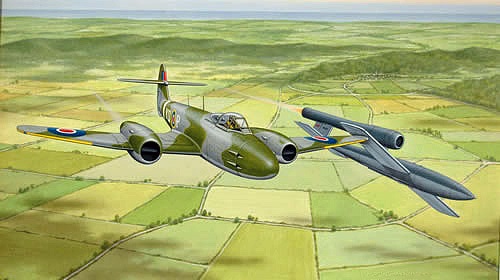
Soon after Dean’s successful V-1 “tip and run”, the first actual V-1 shot down occurred when Flying Officer Roger closed in on a V-1 over Tunbridge and opened fire with all four 20mm cannons. His guns did not jam and the V-1 crashed harmlessly in the open country side. Over the following few weeks, two more V-1s were destroyed as the Meteor pilots honed their proficiency at tracking and destroying the small targets. The Meteors destroyed a total of 13 V-1s in one way or another. Although it seemed like a small kill score, it was a great boost for morale for both the RAF and the civilian population.
Film: The Royal Air Force’s first jet fighter Gloster Meteor F.1, shot down a V1! (in Japanese)
The Luftwaffe started to put its first jet into operational service, the Messerschmitt Me 262 which was delayed several years due to political interference caused by Hilter himself. The Meteor pilots were anxious to deploy across the channel and engage their German counterpart in aerial combat.
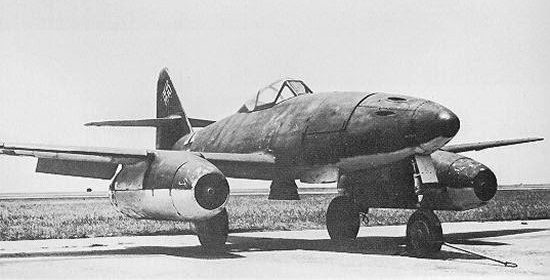
The RAF high command, however, issued orders that the Meteors were not allowed to fly over enemy controlled territory due to the fear that an aircraft might fall into enemy hands. A short time later, the Germans unveiled their next secret weapon, Messerschmitt Me 163 Comet, a rocket propelled fighter. Under pressure from the USAAF and the RAF Bomber Commands, 616 Squadron sent Meteors to Debden for a short period of time so US bomber crews could update their defensive skills against the new threat, jet powered aircraft.
On October 9, four Meteor F.1s were flown to the former RAF airflield at Debden in Essex which was then the base for the USAAF 4th Fighter Group of the US 8th Air Force. A week long joint tactical exercise began the next day with four box formations of B-17s and B-24s bombers assembled with their P-51 Mustang escorts and some P-47 fighter squadrons over Cambridgeshire. The Meteors flew mock attacks against the US planes using hit and run tactics.
Meteor F.1 (serial EE227) of the 616 Squadron on the PSP ramp at RAF Manston, Kent on 4 January 1945. After squadron service, EE227 was transferred to the Royal Aircraft Establishment (RAE) for experimental modifications becoming the only T-tailed Meteor and later became the world’s first turboprop aircraft.

This is my close up of IWM CL 2925. Note that the plane’s individual code letter Y was also repeated on the nose wheel door.

No. 616 Squadron received its first new version of the Meteor, the F.3, EE231, on 18 December 1944 and by 17 January 1945, when they moved from Manston to Colerne in Wiltshire, nearly all the F.1s had been replace by the later F.3.
Film: RAF No 616 Squadron Gloster Meteor
More Photographs:
The RAF decided the Meteor F.3s were ready for combat over Europe and issued orders to deploy them to the continent. On 20 January 1945, four Meteors from 616 Squadron were moved to Melsbroek in Belgium and was attached to the Second Tactical Air Force, just under three weeks after the Luftwaffe’s surprise Unternehmen Bodenplatte attack on New Year’s Day, in which Melsbroek’s RAF base, designated as Allied Advanced Landing Ground B.58, had been struck by the piston-engined fighters of JG 27 and JG 54. The 616 Squadron Meteor F.3s’ initial duty was to provide air defence for the airfield but the pilots were hoping that their presence might provoke the Luftwaffe into sending Me 262s against them. At this point the Meteor pilots were still forbidden to fly over enemy-occupied territory, or to go east of Eindhoven, to prevent a downed aircraft from being captured by the Germans or the Soviets.
Ground crew positioning Meteor F.3, EE239 ‘YQ-Q’, of 616 Squadron at Melsbroek, Belgium, late January 1945. All-white finish was applied to the four F.3s sent to Belgium as a recognition aid for the ground troops during familiarization training before the operational F.3 aircraft arrived. It was also camouflage for the Meteors when the airfields were snow covered – IWM CL 2934
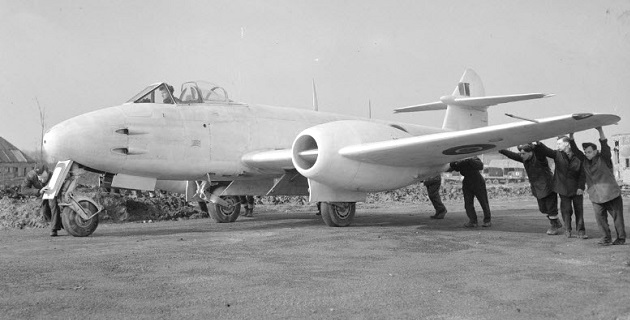
In March, the entire squadron was moved to Gilze-Rijen and then on April 13, to Nijmegen. The Meteors flew armed reconnaissance and ground attack missions without encountering any German fighters.
This photo was taken at a base near Nijmegen (Netherlands) in April 1945. The airbase where this photo was taken was semi permanent and built in March 1945. It was named Airstrip B.91 and was a complete airbase where heavier multiple engine USAAF bombers could also take off and land.
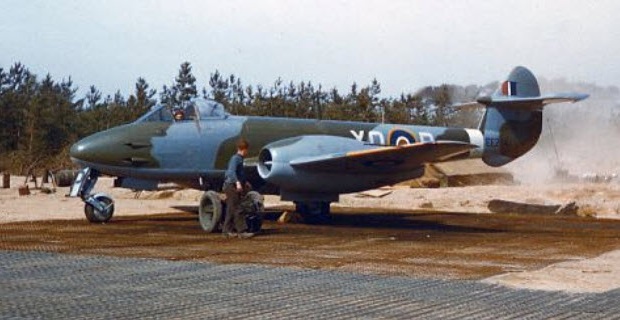
On April 20, as the Allies advanced into Europe, the 616 Squadron moved with them. For five days they were based at Quackenbruck, southeast of Bremen, Germany, before moving once more to Faßberg. These rapid movements caused problems for the Meteors. One was finding suitable landing fields for the jets. The squadron had flown from Pierced Steel Plank (PSP) strips or grass fields against the advice of the Gloster engineers. Shortly after the move to Faßberg, the squadron suffered its first losses when two Meteors collided in poor visibility which killed both pilots.
Friendly fire caused by being identified as being Me 262s by Allied anti-aircraft gunners was becoming more of a threat than the already diminished Luftwaffe. To alleviate this problem, all continental based Meteors were given an all-white finish as a recognition aid. Note the serial number was not over painted.
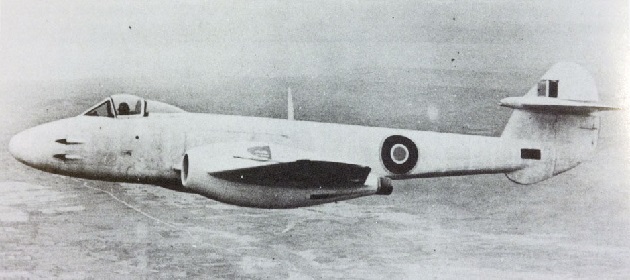
On 2 May 1945, a Meteor pilot attempted to engage a German Fieseler Fi 156 Storch, but the more maneuverable light liaison plane was able avoid the Meteor’s gun fire and land. After it landed, the Storch was destroyed in a strafing attack. During the last days of the war in Europe, the Meteor came close to engaging German fighters. Four Meteors came across a number of Focke-Wulf Fw 190s and as the British jets prepared to engage the enemy fighters, a number of British Tempests and Spitfires mistook the Meteors as Me 262s and prepared to attack what they thought were enemy aircraft. The confusion caused the Meteors to break off their attack on the German fighters.
The war ended with the Meteors having destroyed 46 German aircraft through ground attacks. The Meteor never got the chance to prove itself against any Luftwaffe aircraft in aerial combat.
Post WWII
Following WWII, some normality returned to the UK for a short while but a new threat loomed from the east in the form of the Soviet Union, the cold war had begun. The Meteor F.3 was then serving with 16 RAF front line squadrons but with advances in jet designs it became necessary to improve the Meteor in order to keep it abreast with newer aircraft. The next variant, the Meteor F.4 had new longer engine nacelles that were slightly longer both ahead and behind the wing which improved the buffet effect and reduced drag. Rolls Royce developed an improved power plant for the Meteor which was a smaller version of the Nene engine (same engine used in the MiG-15) known as the Derwent 5 which increased the aircraft’s maximum speed to 585 mph at sea level compared to 415 mph of the F.3. The aircraft was also modified with a pressurized cockpit and a strengthened air frame to handle the extra stress from the increased thrust.
In 1947, the Meteor F.4 started to reach the RAF front line squadrons replacing the older F.3s. Also the first export orders were delivered to other nations:
Argentine Air Force: 100
Belgian Air Force: 48
Royal Netherlands Air Force: 38
Danish Air Force and Navy: 20
Korean War
The Royal Australian Air Force (RAAF) No. 77 Squadron was formed at RAAF Station Pearce, Western Australia, in March 1942 and saw action in the South West Pacific theater of WWII, operating Curtis P-40 Kittyhawks. After the war, the squadron was re-equipped with North American P-51D Mustangs and deployed to Japan as part of the British Commonwealth
Occupation Force (BCOF).
On 25 June 1950, the North Koreans crossed the 38th parallel and invaded South Korea. At that time, the RAAF 77th Squadron was scheduled to re-deploy back to Australia. In response to the United Nations (UN) urgent request for military forces to counter the communist invasion of South Korea, the Australian government decided to commit the 77th Squadron to the UN forces and the squadron was sent to Iwakuni, Japan. The 77th squadron Mustangs operated between Iwakuni and Taegu flying daily missions escorting USAF B-26/B-29 bombers, fighter bombers and made numerous attacks against ground targets in Korea. After the Inchon invasion on 11 October 1950, the 77th squadron moved to Pohang, in Korea’s southeast corner which a month earlier was at the northeast corner of the Pusan Perimeter and continued operations.
China’s entry into the war in November 1950 resulted in a complete change in the status of the communist’s air power because they introduced the swept wing Mikoyan-Gurevich MiG-15 high performance jet fighter (NATO coded name: Fagot) to the war. USAF and RAAF Mustangs began to encounter MiGs while on patrols and they did not stand a chance against the MiG-15 in aerial combat. The USAF countered the MiG-15 threat by moving the 4th Fighter Interceptor Wing (FIW) equipped with North American F-86 Sabres to Yokusuka, Japan arriving on 13 December 1950. On December 17, Lt. Col. Bruce H. Hinton made the first MiG-15 kill by a Sabre jet. The MiG-15 had a performance equal to, and in some cases, better than the F-86 at high altitude, but suffered from a tendency to spin if not maneuvered carefully at medium altitudes. The F-86 had a better gun sight and a greater ability to absorb battle damage.
Although the RAAF Mustangs were doing much more ground support than air defense, the Australian government wanted the 77th Squadron long term role to be air defense – a role which the MiG-15 totally outclassed the Mustang. They wanted to replace the Mustangs with jets as soon as possible. Australia already had a jet, the single engine De Havilland Vampire but it was an older first generation design and was quickly ruled out. Their first choice was to purchase the US swept wing F-86 Sabre but because of the long waiting list they would not receive them until 1954.
The Australians then approached the British and they agreed to supply them Gloster Meteors. In December 1950, the Australian government purchased Meteors that were earmarked for the RAF. The British delivered the Meteors with commendable speed since it brought in export income to the UK and provided a chance to prove the Meteor in combat. On 24 February 1951, the Royal Navy aircraft carrier HMS Warrior arrived in Japan with 15 Meteor F.8s and 2 Meteor T.7 trainers. Four weeks later on March 23, 22 more Meteor F.8s were delivered. Another 58 Meteors and more trainers were delivered in two batches later on. RAAF technical staff trained on the Meteor also arrived in Japan along with four experienced RAF officers.
A comparative performance trail was performed between a F-86 Sabre and a Meteor F.8. The results showed that the Sabre proved better in a dive or when flown straight and level, but the Meteor had a better sustained climbing performance and could out turn the Sabre. The Meteor also was not fitted for ‘G suits’ which applied pressure to the lower body and helped the pilot to withstand the ‘gut-wrenching’ high Gs during pullouts which usually caused the pilot to temporary black out.
On 6 April 1951, the 77th Squadron flew their last Mustang sorties in Korea and were pulled from front lines for conversion training on the Meteor. There was no Meteor training in Australia, all the training was done at Iwakuni, Japan. The pilots learn how the aircraft worked and how to fly it safely. The twin engines made it a powerful aircraft for its time and provided additional survive ability if one engine was damaged in combat. As part of the training, the pilots had to master single-engine operations in the Meteor which probably saved many pilot lives later in Korea.
In June 1951, Lieutenant General Sir Horace Robertson, the Australian commander of the BCOF in Japan issued a directive that each Meteor have to be fitted with a radio compass before it can beaccepted for RAAF service in the Korean theater of operations. In early June, a shipment of AN/ARN-6 radio compasses (the same one used in the USAF F-86s) were rushed to Japan. Problems were encountered for the location of the loop aerial which could not operate under metal. The F-86’s fully transparent canopy accommodated the aerial just aft of the pilot’s seat but the Meteor’s hood with its rear metal portion made it impossible for a similar installation to be made. After much redesign work, the Meteor’s aerial mast mounting was modified to take the loop aerial which was then encased in an Australian-produced perspex blister.

The radio compass consisted of an antenna, a receiver, a control unit and a display all of which was squeezed into a cockpit not designed to take them. The location of the radio compass control unit was initially awkward for frequency changing. The pilot had to unstrap, wiggle around to the right as far as possible and extend his left hand into the right rear recess of the cockpit and was barely able to nudge the crank handle in small increments. The control box was later moved to beside the pilot’s seat but it could not be seen directly, the frequency display was reflected in a mirror. To overcome tuning problems, the radio compass was preset before flight whenever possible.
Meteor T.7 A77-305 and Meteor F.8 A77-982 flying in formation over Iwakuni, Japan. A77-305 was later renumbered A77-702.
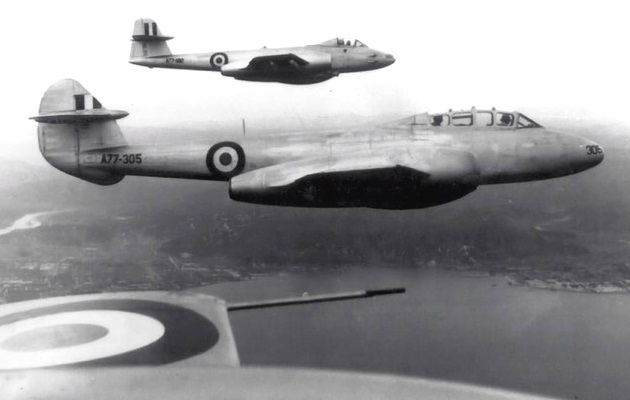
This is another photo of the same flight above. A77-982 was the highest serial number of the Meteors in Korea. Note the ventral fuel tank beneath the Meteor banking to the right in the background.
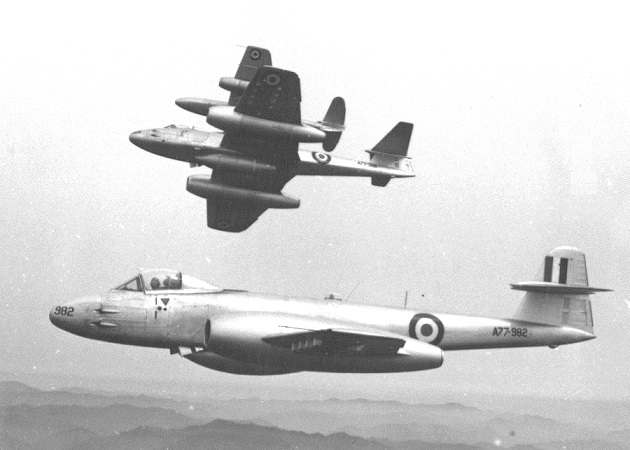
In early July 1951, the 77th Squadron and its new Meteors arrived at Kimpo airbase K-14 (today Gimpo International Airport) located west of Seoul and north east of Inchon. The base commander was USAF Colonel John Tipton and an element of the 4th FIW F-86 Sabres operated from the base. At first, the Meteor pilots flew around the Kimpo area to thoroughly familiarize
themselves with the locality and its facilities. In mid July, the squadron began operating their Meteors on combat missions. The squadron had mostly been trained in the ground attack role and had very little training in air combat tactics. They experienced some difficulties when assigned to bomber escort duty at sub optimum altitudes.
According to Russian records, the first engagement of the 77th Squadron Meteors and MiGs took place on 25 August 1951. A group of bombers consisting of eight B-29s, covered by up to 60 UN fighters approached the area 15 km south of Anju. Under the command of Major G. I. Pulov, 26 MiG-15s of the 17th IAP, 303rd IAD took off and intercepted the enemy force in the Sonchon area. Unfamiliar with the twin engine aircraft among the enemy covering screen of fighters, the MiG pilots decided to test the new enemy aircraft in combat. During the air battle, the Meteors were inferior to the MiGs both in speed and maneuverability and as a result two Meteors were shot down. Major Pulov claimed one and Senior Lieutenant Nikolai Sutyagin claimed the other. But the Australians reported that the 77th Squadron did not engage any MiGs on August 25 and recorded that two Meteors (A77-128 and A77-354) were lost on August 22 during a mid-air collision over Kimpo airfield.
Officially, the Australians maintain that the Meteors of 77th Squadron did not have their first combat with MiGs until August 29. There was in fact a dogfight involving Meteors and MiGs on 29 August 1951 when a group of fighter bombers escorted by 16 USAF F-86 Sabres and two four ship formations of Meteors attempted to attack the hydro-electrical stations on the Yalu River in the Chongju area which was covered by 24 MiG-15s of the 18th GvIAP of the 303rd IAD. One Meteor was lost and two were damaged, and the squadron did not officially destroy any MiGs in this engagement.
The Australians had recorded that A77-721 was the first RAAF Meteor lost in combat in Korea on August 29. Shot down by cannon fire of a MiG-15 approximately 20 miles (32 km) northwest of Anju in the Kunson area. The pilot Warrant Officer Ronald David Guthrie ejected at a height of 8707 meters (28,566 feet), an unofficial record at the time and he was the first RAAF pilot to eject from an aircraft in active service and the second from an RAAF Aircraft. The parachute descent took 28 minutes. Guthrie survived and became a POW until the end of war.
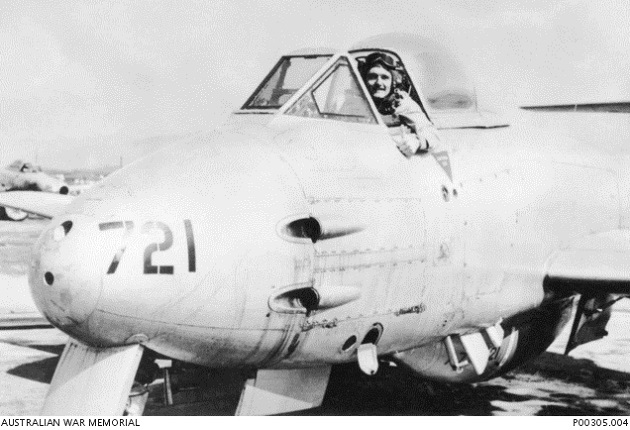
During the engagement, Senior Lieutenant L. K. Shchukin (15 kills) of the 18th GvIAP, 303rd IAD attacked Meteor A77-616 piloted by Squadron Leader Dick L. Wilson. Shchukin’s rounds tore off the Meteor’s port (left) aileron and shot holes in its wing and rear fuselage where shell fragments had riddled the main fuel tank. While appearing to be doomed, Wilson rolled his stricken Meteor over and into a steep dive. Wilson managed to pull out of the dive and get his damaged Meteor back to Kimpo. The ground crew repaired A77-616 which was operational for another five months until 6 February 1952 when flown by pilot Flight Lieutenant J. Hannan was shot down by enemy ground fire and crashed in the Sibyong-Ni area.
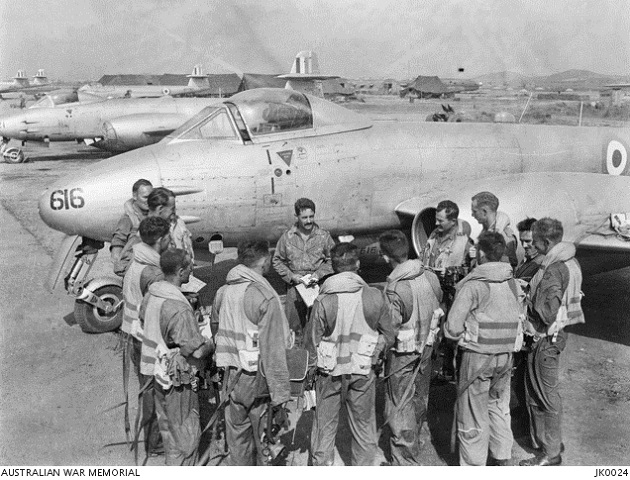
On 5 September 1951, six Meteors were escorting two unarmed RF-80s on a photo reconnaissance mission and were attacked by 12 MiG-15s. Captain G U Okhay (11 kills) of the 523rd IAP, 303rd IAD attacked a pair of Meteors. He fired two short bursts at the lead Meteor from the range of 380 yards (350 meters) and the Meteor started to descend. He then fired a long burst into the wing man at 350 yards (320 meters). Warrant Officer William S. Michelson lost control of his Meteor A77-726 which went into a dive at 26,000 feet (8000 meters). With a heavily damaged tail, Michelson extremely carefully recovered from the dive. His Meteor leveled off at 10,000 feet (3000 meters) after falling 3 miles (5 Kilometers). Okhay only watched the Meteor fall to 16,000 feet (5000 meters) after which he headed home. Michelson managed to limp back to Kimpo and landed his damaged Meteor.
Meteor A77-730 seen on the flight line.
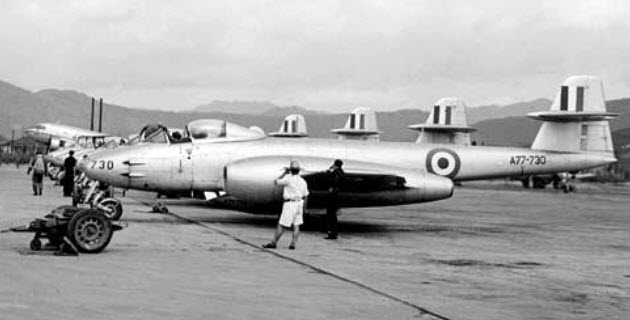
A77-730 made a crashed landing at Kimpo on 7 October 1951. The Meteor was written off and stripped for spare parts.
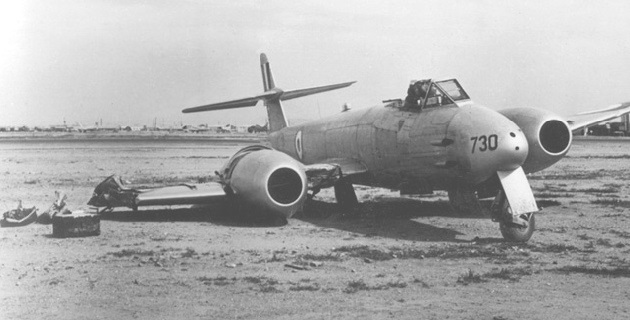
On 24 October 1951, Senior Lieutenant L. K. Shchukin damaged Meteor A77-316 piloted by Flight Lieutenant Phil V. Hamilton-Foster and his rounds pierced the Meteor’s port wing fuel tanks and starboard vertical stabilizer, damaged the fuselage and severed the elevator controls. Soon after the hits, the port engine failed forcing Hamilton-Foster to bank to the left and dive away with his jet trailing smoke. Despite the heavy damage, he did managed to reach Kimpo where on final approach the remaining engine failed but he was able to put his Meteor safely down on the runway.
On 27 October 1951, Flying Officer Les Reading flying A77-29 and his wing man Wally Rivers were escorting eight B-29s attacking a target in the Sinanju area of North Korea. After the bomb run, the formation was attacked from the rear by 10-16 MiG-15s and one B-29 was damaged. One of the MiG-15s passed in front of Reading and Rivers presenting them with an excellent target as it swept away. Reading fired at the MiG hitting the port wing tank near the wing root causing fuel to stream out. Reading and Rivers later had seen a MiG burning in the distance and the pilot of the damaged B-29 reported that Reading had ‘clobbered the MiG.’ At the time, Reading was only credited with a ‘Damaged’ MiG. Decades later, Russian records showed a MiG was lost during the sortie on that day thus giving Flying Officer Les Reading the honor of the first RAAF MiG kill.
On 1 December 1951 during the air battle over Sunchon, 16 Meteors engaged 20 MiG-15s of 176th GvIAP, 324th IAD. The 77th squadron had reported its first two victories. At the time, Flying Officer Bruce Gogerly was credited with the first official MiG kill (Decades later that changed when Reading’s ‘Damaged’ was upgraded to a ‘definite’ kill.) A second MiG was reported as destroyed and the credit was allocated to the squadron as Gogerly, Flight Lieutenant M. Scanell, Flying Officer G. Thornton (the Flight Leader) and Flight Lieutenant L. Cadan all had fired on the MiG. The Australians also reported that 3 Meteors were lost during the air battle. Two of the missing pilots Sergeant B. Thompson (A77-29) and Sergeant V. Drummond (A77-251) were captured after having ejected safely. The third pilot Flight Sergeant E. Armitt (A77-949) was KIA when his Meteor was shot down.
The Russian archives and the recollections of the Russian pilots who participated in the air battle stated that they shot down at least 9 Meteors and all the MiGs had returned to base without any damage.
During the December 1st engagement, Gogerly was not flying his assigned Meteor but was actually flying Warrant Officer Bob Turner’s Meteor A77-15 named “Elyana.”
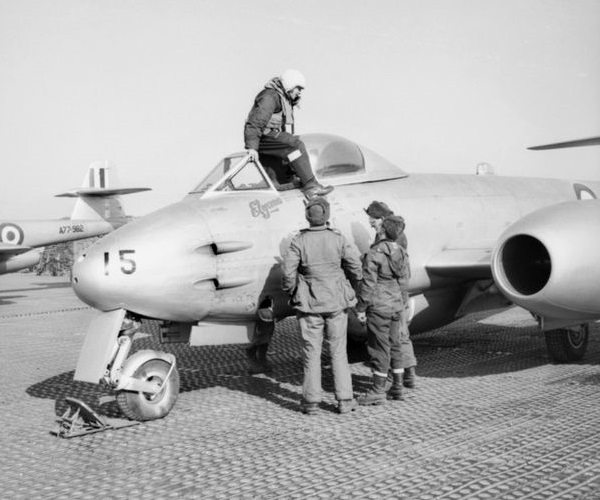
Gogerly’s assigned Meteor was A77-17 named “Audie”. The emblem is a Piping Shrike on a light blue disc which is the emblematic bird that appears on the South Australia flag. The emblem was carried beneath the windscreen and repeated on the nose gear door.
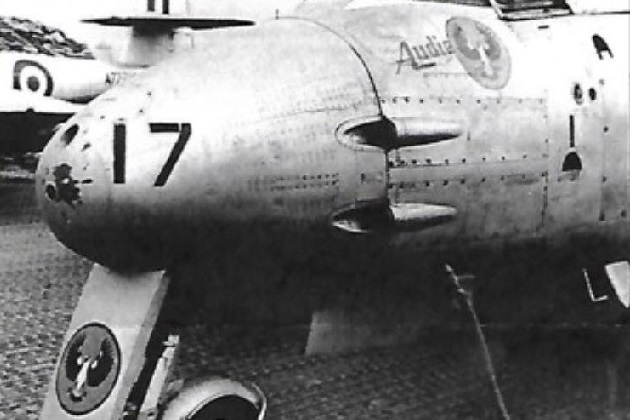
The devil with a red-hot pitch fork was a theme that appeared several times in the 1950s and 1960s on diverse RAAF aircraft. The term “Bowl ’em Over” is a term from the game Cricket, a well-aimed delivery to hit the wicket, the set of three stumps with two balls across the top at either end of the pitch, defended by a batsman.
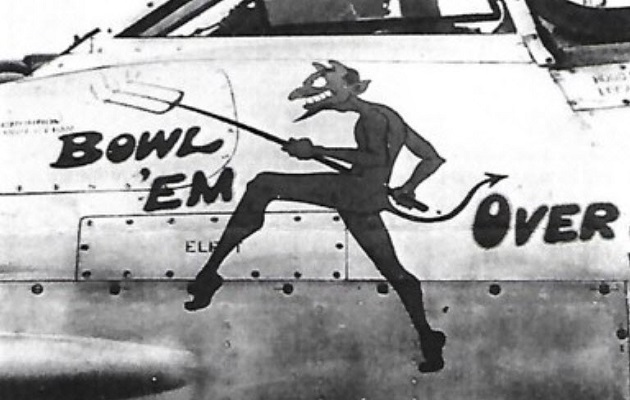
Meteor A77-207 was named “Bowl ’em Over”. A number of publications has A77-17 incorrectly named “Bowl ’em Over.” Note the removed panel on top of the nose.
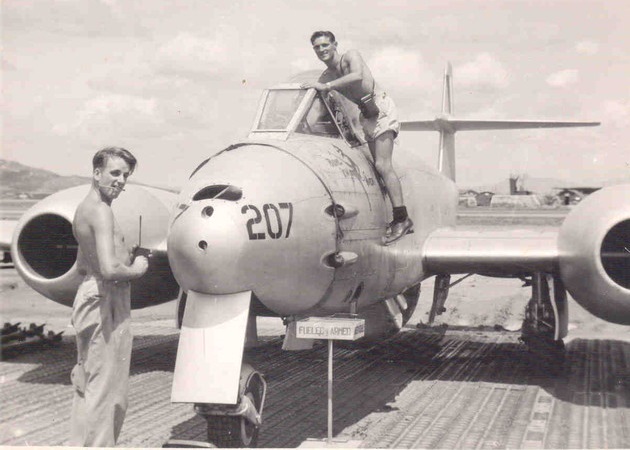
After the heavy losses, the Meteors were withdrawn from ‘MiG Alley’ and were used for airbase protection. Another threat introduced into the air war was ‘Bed-check Charlie.’ Tu-2 bombers, light aircraft and some MiGs ventured south on nuisance night raids over the UN bases. Meteors stood on ready alert and were launched for interception when unidentified bogies appeared on the radar. As a purpose built interceptor with a rapid start up capability and a strong climb performance at lower levels, the Meteor was well suited for airbase protection. The intercept duty was mostly at Suwon, 30 km (18.6 miles) south of Kimpo and was often a boring assignment for the Meteor pilots.
In late December 1951, the Meteors were re-assigned to ground attack missions due to its favorable low-level performance and sturdy construction. Mounts for four rocket launchers were added beneath each wing. This was a dangerous task because the Meteor had to be flown straight and level on its firing run in order for its gyro-stabilized gun sight to operate accurately. The rockets were fired by a US F-80 Shooting Star electrical tank release system which had been modified to the Meteor’s circuitry. The first ground attack with rockets was made on 8 January 1952.
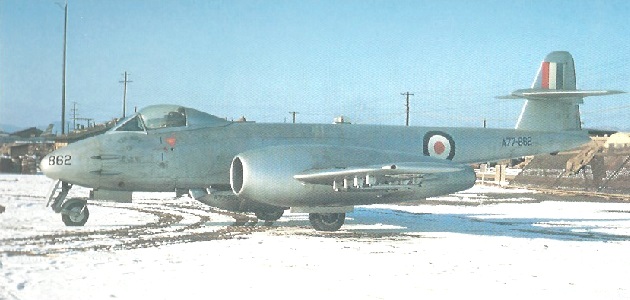
The normal rocket load for the Meteor was eight RP-3 3 inch 60 lbs (27.22kg) SAP rockets but many Meteors were modified to carry a double tier load of 16 60 lbs rockets.
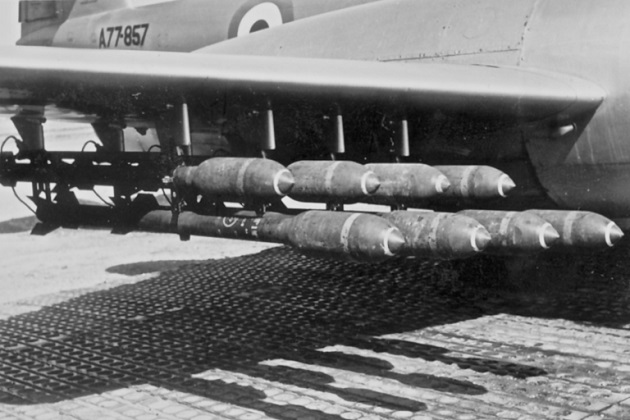
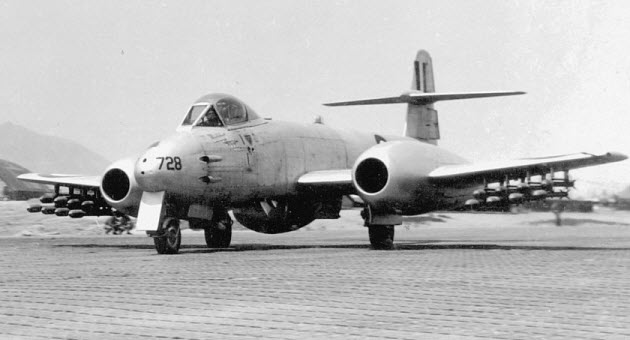
The Flaming Onion
Flight-Lieut J. C. Smith, armament officer of the 91st Wing RAAF based at Iwakuni, Japan invented the RP-3 napalm rocket which was named the “flaming onion.” Napalm is an incendiary material consisting of Naphtha and Palm oil or jellied petrol. The napalm rocket had a five gallon (19 Liters) tank of napalm as its war head and had much greater accuracy than the napalm bomb (which was essentially a drop tank filled with napalm) and was more economical. It was developed to overcome the need to fly slow and straight over a target to deliver conventional napalm. The rockets were very effective against communist targets such as supply dumps, trains and truck convoys.

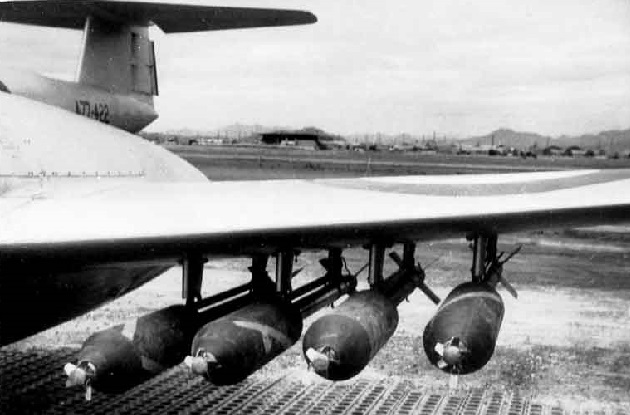
This photo shows a good view of the rear of the warhead.
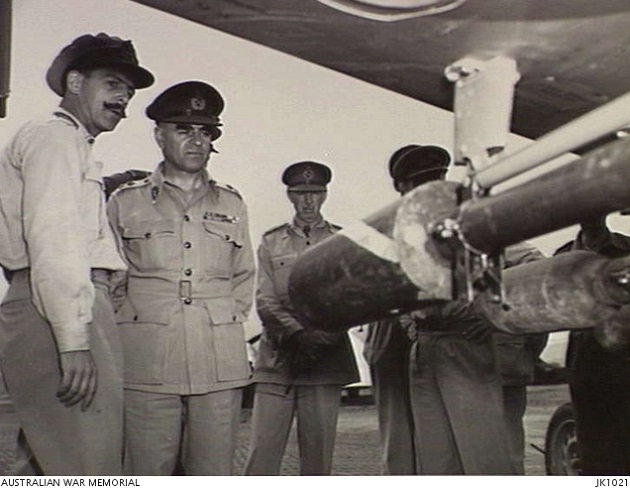
On 8 February 1952, Wind Commander Ronald T. Susans, CO of the 77th Squadron, made the first operational use of the RP-3 Napalm rockets. Four Meteor F 8s led by Susans attacked this North Korean barrack block. This photo was taken by Major Ruffin Gray of the USAF 67th Tactical Reconnaissance Wing flying a Lockleed RF-80A Shooting Star.
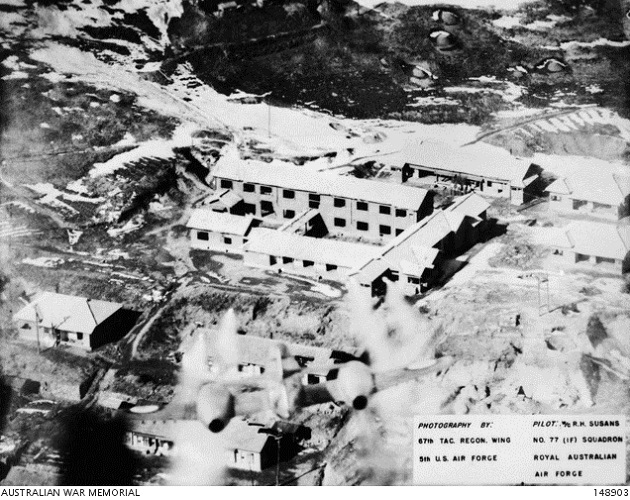
Besides carrying the RP-3 60 lbs rockets, the Meteor F 8 was capable of carrying two 1,000 lbs (453 KG) GP bombs. They were used against larger enemy targets such as bridges, tunnels and dams.
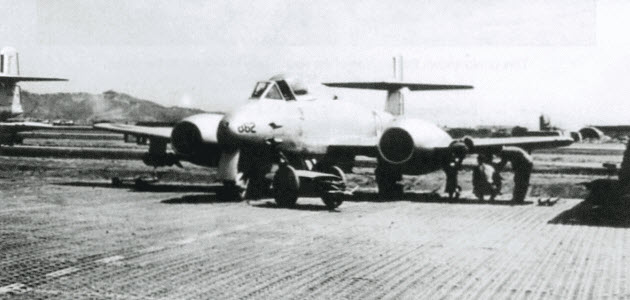
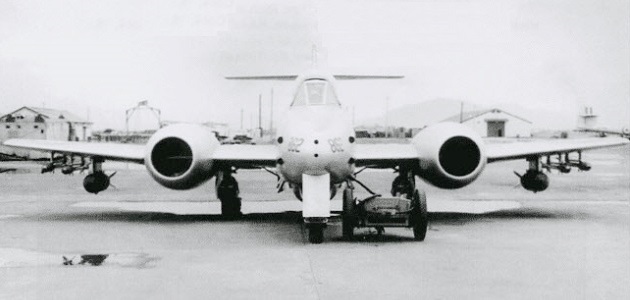
The Meteors had flown over a thousand sorties in the ground attack role until May 1952 when the 77th Squadron switched to fighter sweep operations.
On 4 May 1952, the unit was operating a series of Airborne Alert Patrols over North Korea and Pilot Officer John Surman flying Meteor A77-734 was part of patrol number 11 and flying as number two to Sargeant K. Murray. Around five miles WSW of Pyongyang, they sighted nine MiG-15s about five miles away. Two of the MiGs made a non-firing pass on them. Then Surman
called out that there was a MiG on Murray’s tail. As Murray broke away, Surman fired two bursts of 20mm at the MiG and pieces were observed breaking off the horizontal Stabilizer and flames burst from its rear and fuselage. Sadly, Surman did not survive the war. Flying Meteor A77-911, he was KIA on 9 June 1952 while attacking enemy trucks during an armed reconnaissance mission.
This is the only photo found of A77-734.
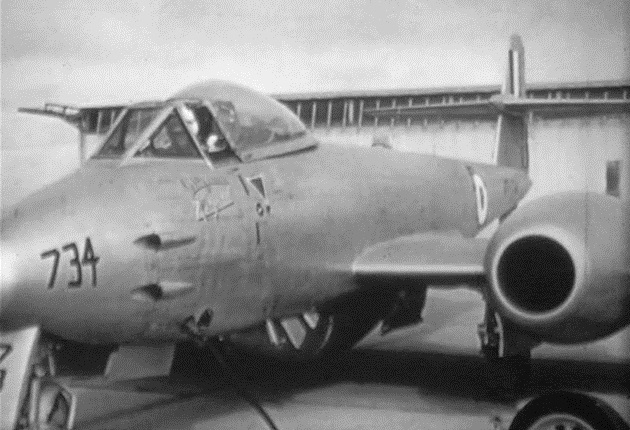
On 8 May 1952, an official Meteor MiG kill was made by Pilot Officer William (Bill) Simmonds. On that day was the largest single attack of the Korean War where 485 UN fighter-bomber sorties concentrated on a major enemy supply depot at Sunan (today the site of the Pyongyany Airport.) That day, the Meteors flew 70 fighter sweeps along the enemy main supply routes and near Sunan providing top cover for the fighter-bombers.
Simmonds flying A77-385 named “Chloe” was in a flight of four Meteors when they were attacked by MiGs from behind. He became aware of the attack when tracer rounds passed over his wing. His attacker then passed only a few meters below him and he was able to get on the tail of MiG and into a good firing position. He fired a long burst of 20mm and hit the MiG which then went into a diving spin. The MiG pilot bailed out and parachuted down as his smoking jet crashed to earth.
On 11 May 1952 three days later, A77-385 made a crashed landing at Kimpo due to battle damage from a MiG and the aircraft was written off.
Simmonds in the cockpit of his assigned Meteor A77-744 named “Miss Bunbury.”
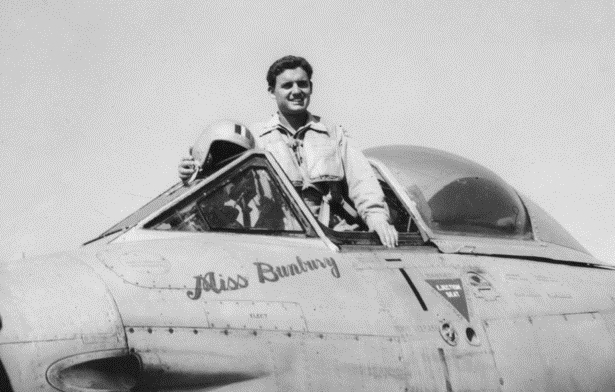
Meteor jets heading for Korea are lined up on the flight deck of the HMS Unicorn in Singapore in 1952. The aircraft were flown from the UK. Note the auxiliary fuel tanks mounted under the wings.
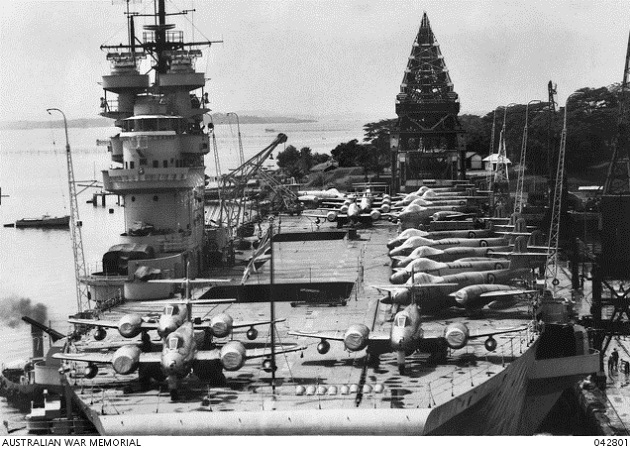
The Meteors are unloaded from the flight deck of the HMS Unicorn to lighters at Iwakuni, Japan 1952.
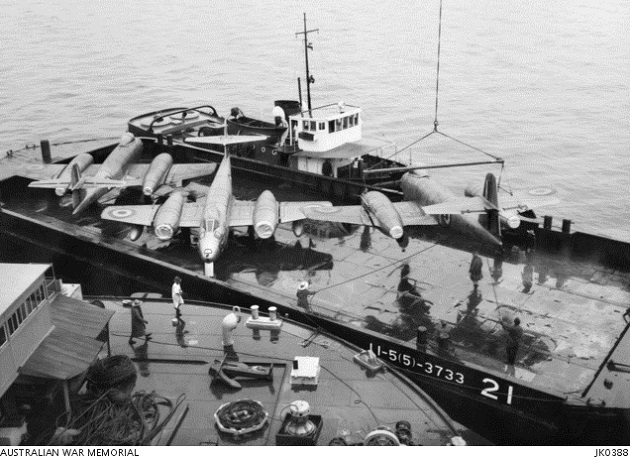
On 29 November 1952, Ken Godfrey was one of 12 Meteor pilots attacking a heavily defended supply area in North Korea. Heavy snow made target identification difficult which delayed the attack and alerted the enemy AA defenses as they circled and descended below 10,000 feet to get a better look. During his attack dive, Ken felt a heavy thump on the left side of his Meteor and knew he had been hit by flak. An enemy 37mm AA shell had hit his port engine. Besides the engine, his radio, airspeed indicator, altimeter and some other instruments were also knocked out. Knowing how POWs were treated rather than ejecting from his severely damaged aircraft, Ken headed back to Kimpo and managed to land his crippled Meteor.
In this photo, Ken is inspecting the battle damage on A77-207 named “Bowl ’em Over.” The damaged engine was replaced and A77-207 did survive the war.
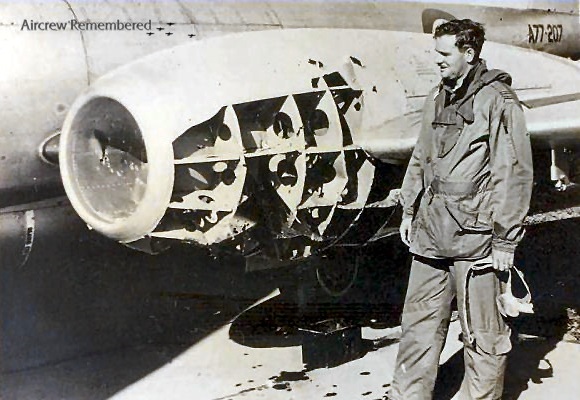
On 27th March 1953, Sergeant George Hale (A77-851) and David Irlam (A77-446) was flying to the southeast of Pyongyang and had descended to about 10,000 feet (3000 meters) to patrol a supply route when he spotted a MiG chasing two USAF RF-80 Shooting Stars a little below them. Although his gun sight was not set up, he dived in to attack and saw another MiG behind the first.
Banking hard left, he fired at the second MiG and missed. Another MiG came up beside him, so he turned towards it, popped his air brakes to slow down and once behind it fired, hitting it a number of times but not downing it. Hale realized he was in for a fight so he jettisoned his ventral fuel tank, readied his gun sight, and prepared to fire his rockets to get rid of them.
As other MiGs joined in, the scene became more confusing. Irlam called out that he was hit. Hale then found himself behind two MiGs and fired two rockets between them, almost hitting one. That split up the two MiGs so he chased one, only to see two more MiGs appear on his left. He got in a shot at one which caused a large white explosion (almost certainly large quantities of fuel), but the aircraft kept flying and the two MiGs applied power and climbed steeply away. Given the amount of fuel lost, the MiG would not had flown for long and it was assumed it would not get back to its base.
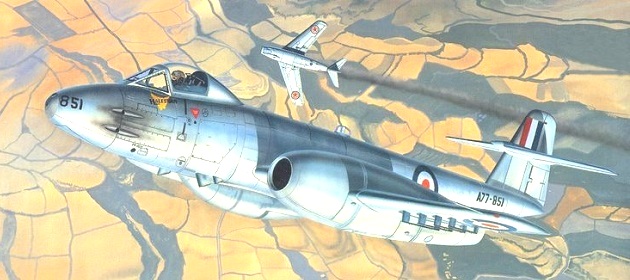
Irlam did not see his attacker and was heavily damaged. He lost an engine and with over 100 holes in his Meteor headed for home, reaching Kimpo safely with the aid of radar guidance and a bit of luck. John Hubble had seen Irlam being attacked and joined in, along with his wing man, Sainsbury ‘Sainy’ Rees, who hit a MiG but believed he only damaged it. After the analysis of the engagement, Hale was credited with one MiG destroyed and one probable, and became the last Australian to shoot down an enemy aircraft in aerial combat.
Video: hale george 35090
Hale was photograph next to A77-851 after the engagement. Someone scratched “MIG KIILLER” in the blacken area made by the 20mm cannons muzzle flash.

The A77-851 crew chief painted two MiG-15 silhouette kill markings below the name “Halestorm” however the squadron CO at the time ordered them removed because it was against regulations. Note that none of the Meteors carried any kill markings during the war.
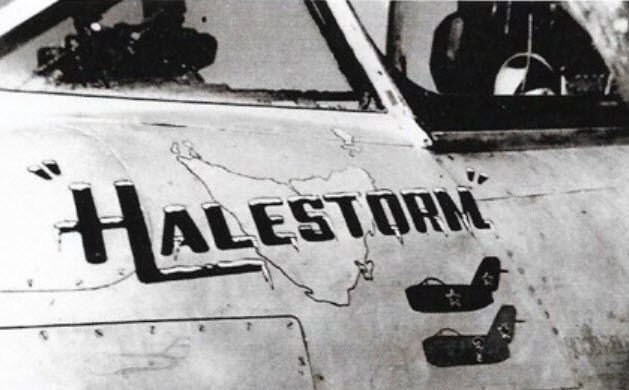
Photos of A77-851 on the flight line.
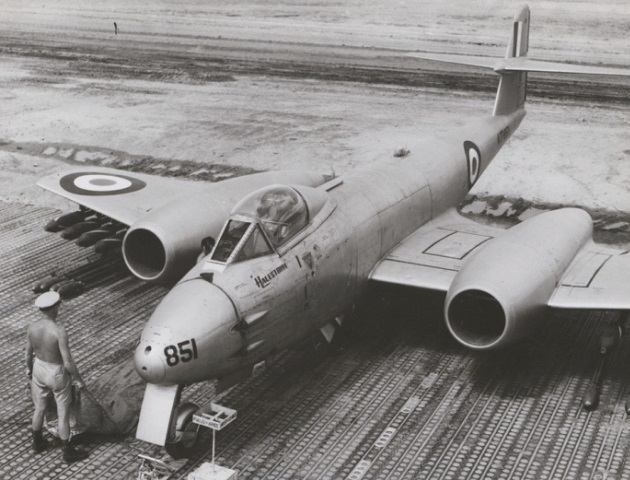
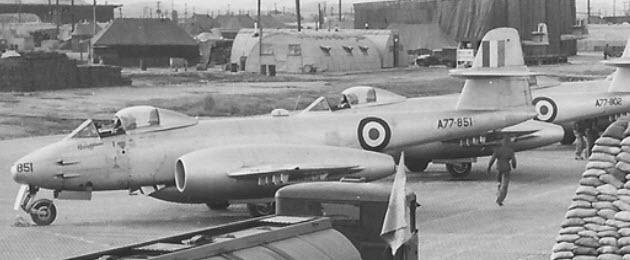
By the end of the war, the RAAF Meteors had flown 4,836 missions, destroying 3,700 building structures, 1,500 vehicles and numerous bridges, locomotives and railroad cars in the process. They also accounted for at least 5 MiG-15 fighters, but these achievements came at a heavy cost, with 32 Meteors lost in combat, many of which also claimed the lives of the brave pilots.
Film: RAAF Gloster Meteors F-8 in Korea (1953)
Film: Korean strike No. 77 Sqn RAAF
Film: [77 Squadron RAAF in Korea]
Film: 77 Squadron RAAF Meteors
Post Korean War
Meteor A77-851 did survived the war. It is seen here being transferred to the aircraft carrier HMAS Vengeance at Iwakuni Japan, 1953-54.

Surviving Meteors on the flight deck of the HMAS Vengeance being transported back to Australia. The outer wing sections were removed to conserve space.
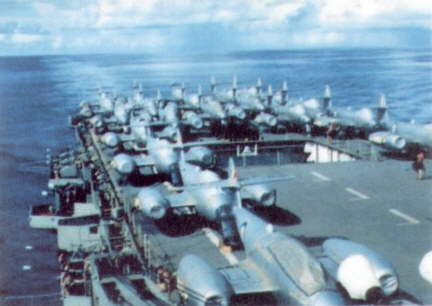
A77-851 and other surviving Meteors were transferred to RAAF Base Woomera, South Australia and were converted to U.21A drones and used on the rocket testing range.
RAAF EDINBURGH, SOUTH AUSTRALIA
The remains of Meteor A77-851 was found dumped between buildings on the base in February 1965.
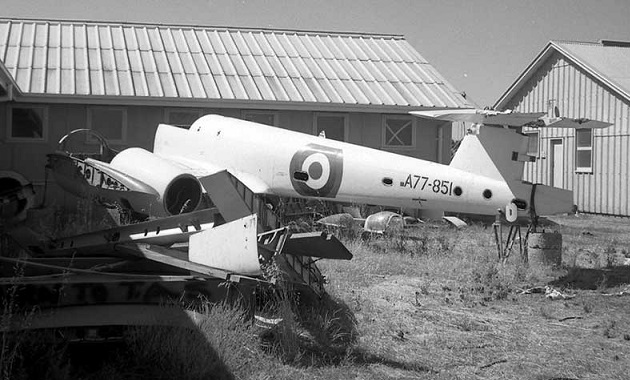
Many decades later, the cockpit and nose from A77-851 was rescued and is currently on displayed at the South Australian Aviation Museum at Port Adelaide.
Video: The Meteor – RAF’s Top 10 Warplanes | Forces TV
Temora Aviation Museum
The Meteor was built by Gloster in 1949 carrying RAF serial number VZ467 and served until 1982. Its last military role was as a target tug. After retired from the RAF, the Meteor was privately owned and operated in the UK. The Temora Aviation Museum purchased the Meteor and it was disassembled, transported to Australia and reassembled at Bankstown NSW. In August 2001, the Meteor flew from Bankstown to its new home in Temora, where it was maintained in an airworthy condition making it the only Gloster Meteor F.8 flying in the world.
The Museum repainted the Meteor with the markings of RAAF 77 Squadron A77-851 flown by Sgt. George Hale. This aircraft is now part of the Air Force Heritage Collection donated by the Temora Aviation Museum in July 2019.
Video: The Worlds Only Airworthy Gloster Meteor F.8 Jet Fighter
The Russian pilots that flew over Korea belonged to the 64th IAK.
Listed below are 10 Russian Aces who claimed a total of 17 Meteor Kills.
| Rank | Pilot | Air Regiment | Air Division | Claims |
| Maj | S. P. Subbotin | 176th GvIAP | 324th IAD | 1 Meteor |
| Capt | G. I. Ges | 176th GvIAP | 324th IAD | 1 Meteor |
| Capt | S. M. Kramarenko | 176th GvIAP | 324th IAD | 2 Meteors |
| Sen Lt | N. V. Sutyagin | 17th IAP | 303rd IAD | 2 Meteors |
| Capt | G. U. Okhay | 523rd IAP | 303rd IAD | 3 Meteors |
| Sen Lt | L. K. Shchukin | 18th GvIAP | 303rd IAD | 2 Meteors |
| Maj | G. I. Pulov | 17th IAP | 303rd IAD | 1 Meteor |
| Maj | D. P. Oskin | 523rd IAP | 303rd IAD | 2 Meteors |
| Capt | P. S. Milaushkin | 176th GvIAP | 324th IAD | 2 Meteors |
| Col | S. F. Vishnyakov | 176th GvIAP | 324th IAD | 1 Meteor |
Definitions:
IAK – Istrebitelniy Aviatsionniy Korpus (Fighter Air Corps).
IAP – Istrebitelniy Aviatsionniy Polk (Fighter Air Regiment)
GvIAP – Gvardeyskiy Istrebitelniy Aviatsionniy Polk
(Guards Fighter Air Regiment)
IAD – Istrebitelniy Aviatsionniy Diviziya (Fighter Air Division)
The following are RAAF 77th Squadron confirmed MiG Kills to date.
A trailing asterisk indicates that the kill was confirmed after the war.
| Date | Rank | Pilot | Meteor Serial / Name |
| 27 October 1951 | Flying Officer | Les Reading * | A77-29 |
| 1 December 1951 | Flying Officer | Bruce Gogerly | A77-15 “Elyana” |
| 4 May 1952 | Pilot Officer | John Surman * | A77-734 |
| 8 May 1952 | Pilot Officer | William Simmonds | A77-785 |
| 27 March 1953 | Sargeant | George Hale | A77-851 “Halestorm” |
Note:
The last MiG kills (Surman, Simmonds and Hale) were most likely belonged to the People’s Liberation Army Air Force (PLAAF), also known as the Chinese Air Force. Only the Chinese operated small groups of MiGs in the Pyongyang area. The J-2 was the Chinese version of the MiG-15bis.
The following Meteors are confirmed as being used by the RAAF during the Korean War although not always in the theater of operations. The individual RAAF serials are listed below including their renumbering where applicable and the original RAF serials are followed in parenthesis. A trailing asterisk indicates that the Meteor was lost, either in aerial combat, by AA fire or by a flying mishap in operational service.
Meteor T 7 (Trainers)
A77-2 (VW410)
A77-229 / A77-701 (WA731)
A77-305 / A77-702 (WA732)
A77-380 / A77-703 (WG974)
A77-577 / A77-704 (WG977) *
A77-705 (WA680)
A77-706 (WF843)
A77-707 (WH118)
Meteor F 8
| A77-11 (WH259) * | A77-464 (WA958) * | A77-863 (WK730) |
| A77-15 (WE911) * | A77-510 (WH251) | A77-864 (WK735) * |
| A77-17 (WA964) | A77-559 (WE910) * | A77-865 (WH405) |
| A77-29 (WA938) * | A77-570 (WE890) * | A77-866 (WH414) * |
| A77-31 (WE903) | A77-587 (WA939) * | A77-867 (WK685) |
| A77-46 (WF746) * | A77-616 (WA956) * | A77-868 (WK674) |
| A77-65 (WH475) | A77-627 (WE928) * | A77-869 (WK727) |
| A77-120 (WE880) * | A77-643 (WE886) * | A77-870 (WK748) |
| A77-128 (WE908) * | A77-721 (WA954) * | A77-871 (WK791) |
| A77-134 (WE898) * | A77-726 (WA957) * | A77-872 (WK792) |
| A77-139 (WA949) * | A77-728 (WA951) * | A77-873 (WK796) |
| A77-157 (WE889) | A77-730 (WA782) * | A77-874 (WK909) |
| A77-163 (WA941) * | A77-734 (WE907) | A77-875 (WK798) |
| A77-189 (WA961) * | A77-735 (WA942) * | A77-876 (WK800) |
| A77-193 (WE969) | A77-740 (WA948) * | A77-877 (WK913) |
| A77-207 (WE905) | A77-741 (WA947) * | A77-878 (WK907) |
| A77-231 (WA944) * | A77-744 (WA786) | A77-879 (WK821) |
| A77-251 (WE906) * | A77-793 (WH252) | A77-880 (WK910) |
| A77-258 (WH254) | A77-800 (WK670) * | A77-881 (WK944) |
| A77-316 (WA945) * | A77-802 (WA998) | A77-882 (WK937) |
| A77-343 (WH274) * | A77-811 (WA937) * | A77-883 (WK912) |
| A77-354 (WA934) * | A77-851 (WK683) | A77-884 (WK931) |
| A77-368 (WA952) | A77-853 (WK715) * | A77-885 (WK973) |
| A77-373 (WA936) * | A77-854 (WK650) | A77-886 (WK938) |
| A77-385 (WE918) * | A77-855 (WK728) | A77-911 (WA946) * |
| A77-393 (WE877) * | A77-856 (WK686) * | A77-920 (WF653) * |
| A77-397 (WE896) | A77-857 (WK684) * | A77-949 (WA960) * |
| A77-415 (WE900) * | A77-858 (WK682) * | A77-953 (WE874) * |
| A77-422 (WF750) | A77-859 (WK688) * | A77-959 (WE909) * |
| A77-436 (WE971) * | A77-861 (WH418) | A77-982 (WA950) * |
| A77-446 (WA783) | A77-862 (WH417) * | Total 92 |
MODELS AND DECALS
1/32:
Fly Model 87 Gloster Meteor MkIII (Scale: 1:33)
Tigger Models 10 Gloster Meteor F-8 – 2010 (Vacuformed)
1/48:
Airfix A09184 Gloster Meteor F.8 Korea – 2017
AMT 825 Gloster Meteor Mk.I With Fieseler Fi 103 V-1 – 2013
Classic Airframes 466 Gloster Meteor F.8 Early Version – 2003
Tamiya 61051 Gloster Meteor F.1 – 1997
Tamiya 61065 Gloster Meteor F.1 – V-1 (Fieseler Fi103) – 1999
Tamiya 61083 Gloster Meteor F.3 – 2002
Loon Models LO48210 Gloster Meteor tires/wheels with wheel wells and ARN-6 Radio Compass
Loon Models LO48213 Gloster Meteor Air-to-Ground Eight Rocket Kit
Red Roo Models RRR48136 Gloster Meteor Mk8F RAAF ADF Fairing set
Red Roo Models RRD4855 Gloster Meteor – “MiG Killers” 77 Sqn RAAF Decals – 2017
Red Roo Models RRD4856 Nose Art Part 1 77 Squadron RAAF
1/72:
Airfix 02038 Gloster Meteor III – 1999
Airfix A50039 Dogfight Doubles V1 Flying Bomb|Gloster Meteor III – 2008
Cyber Hobby 5044 Gloster Meteor F.3 – 2010
Cyber Hobby 5084 Gloster Meteor F.1 – 2011
MPM Production 72543 Gloster Meteor Mk.8 “No. 77 Sq. RAAF over Korea” – 2007
MPM Production 72563 Gloster Meteor F. Mk.III “WWII Jet” – 2010
MPM Production 72567 Gloster Meteor F Mk.I The First British Jet Fighter – 2011
Red Roo Models RRR72116 RAAF F.Mk8 Meteor ADF Fairing
Red Roo Models RRR72125 60LB Warhead Rockets RAAF Meteor Mk8
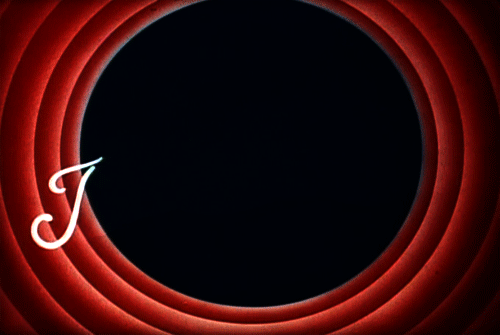
Wonderful website and what a terrific researcher
LikeLike